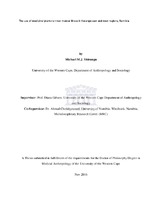| dc.description.abstract | The thesis examines mental illness as it is understood and treated by traditional healers in Kavango, based on ethnographic data collected over twelve (12) months in three (3) different phases from 2014 to 2016. The thesis offers ethnographic material and theoretical insight on the socio-cultural construction of three common mental disorders (CMD) which were identified and treated by traditional healers: Nyambi, Kasenge and Ndjangura. I employed the ‘cultural models’ of Dahlberg et al (2010, p. 282) as a framework to understand mental illness and its treatment by traditional healers - who deal with sick persons on a daily basis. The three common mentally related illnesses appear to be specific to the Kavango people, based on their cultural settings. I argue that these mental illness categories are not fixed or objective, but rather reflect the expertise of the Vanganga (Traditional healers) who identify them, and ultimately treat the afflicted. While traditional healers themselves assume that these local notions of mental illness are static, in reality they are not. Rather, these are active concepts constituted by culturally and socially relative categories whose precise boundaries and meanings vary and are highly contested. It was evident that the conceptualization (expression of belief patterns, thoughts and ideas) by the Vanganga (Traditional healers) of the three local mentally related illnesses differed, in the ways they perceived and treated similar conditions. The manner in which these perceived signs and symptoms informed their diagnoses differed, but also overlapped: in terms of basic assumptions that underlay explanations and treatment, and the ways in which the conditions became manifest. The thesis postulates that Traditional healers form part of the local health care system, historically unregulated. There have been calls for the recognition and regulation of traditional healers and their medicines, but to date such recognition and regulation has, if anything, been sporadic, insufficient and controversial. In response to this I provide a new way of classifying traditional healers in Kavango and propose the use of three categories: Kangangwena (assistant traditional healer), Nganga (general traditional healer) and Nkurunganga (expert traditional healer). The thesis discusses the cultural epistemology of traditional healing concerning the use of medicinal plants as treatment for mental illness. Plant knowledge and its application by traditional healers is explored, with the emphasis on the medicinal plants used to treat various mentally related illnesses. In addition, administration methods and the medicinal plants used in the treatment of mental illness are examined. I argue that medicinal plants are believed to possess powers that need to be "enticed or seduced" by healers, in order to produce a therapeutic effect on the muveri (sick person). I contend that medicinal plants are perceived to have an agentivity which is embedded in the community and people who utilize them. Thus, I intend to show that medicinal plants have power that work at different levels via ritual healing ceremonies and communication to the ancestors, as a way of "seducing" them to bring forth their therapeutic effect on the sick person. The plants in question were "seduced" inter alia by boiling, powdering, crushing and soaking, to increase their rate of reaction and generate more therapeutic power. A total of 37 medicinal plant species belonging to 24 families were reported to be used traditionally in Kavango regions in Namibia, to treat the five different categories of mental disorders. The most reported use of plants was of Albizia tanganyicensis, Ancylanthos rubiginosus, Bobgunnia madagascariensis, Dialium engleranum Diospyros virgata, Elaeodendron transvaalense and Guibourtia coleosperma. Roots and leaves were most frequently used in treatment. Remedies were prepared by boiling, while oral intake and steaming were most commonly used by healers to administer them. | en_US |

